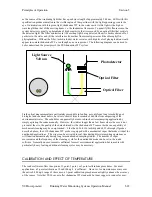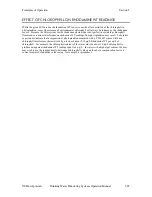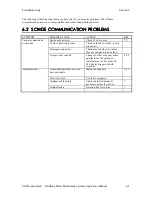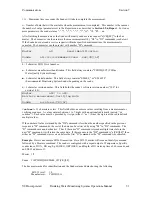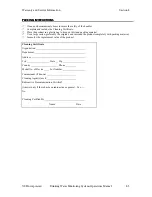
Principles of Operation
Section 5
YSI Incorporated Drinking Water Monitoring Systems Operation Manual
5-23
as the source of the irradiating light that has a peak wavelength of approximately 540 nm. LEDs with this
specification produce radiation in the visible region of the spectrum with the light appearing green to the
eye. On irradiation with this green light, rhodamine WT in the water emits visible light with a higher
wavelength than that of the exciting beam, i.e. the rhodamine fluoresces. To quantify this fluorescence, the
system detector is usually a photodiode of high sensitivity that is screened by an optical filter that restricts
the detected light. The filter minimizes (a) the exciting light being detected when it is backscattered off of
particles in the water and (b) the interference from other fluorescent species such the chlorophyll in
phytoplankton. Without the filter, turbid (cloudy) water or water with high levels of phytoplankton would
appear to contain rhodamine WT, even though none were present. The following diagram can be used to
better understand the principles of the YSI rhodamine WT system.
Field optical measurements are particularly susceptible to fouling, not only from long term build up of
biological and chemical debris, but also to shorter term formation of bubbles from outgassing of the
environmental water. These bubbles can generally be removed in short term sampling application by
simply agitating the sonde manually. However, for studies longer than a few hours where the user is not
present at the site, the quality of the data obtained with a rhodamine WT sensor that has no capability of
mechanical cleaning may be compromised. Like the 6026 /6136 turbidity and 6025 chlorophyll probes
described above, the 6130 rhodamine WT probe is equipped with a mechanical wiper that makes it ideal for
unattended applications. The wiper can be activated in real-time during discrete sampling operations or
will function automatically during long term unattended sampling studies. The number of wiper
movements and the frequency of the cleaning cycle for the unattended mode can be set in the sonde
software. Generally one movement is sufficient for most environmental application, but in media with
particularly heavy fouling, additional cleaning cycles may be necessary.
CALIBRATION AND EFFECT OF TEMPERATURE
The sonde software offers the option of 1 point, 2 point, or 3 point calibrations procedures. For most
applications, a 2-point calibration at 0 and 100 ug/L is sufficient. However, for maximum accuracy over
the entire 0-200 ug/L range of the sensor, a 3-point calibration procedure can slightly enhance the accuracy
of the sensor. Note that YSI does not offer rhodamine WT standards, but does suggest a vendor for user-
Optical Fiber
Photodetector
Light Source
540 nm
Optical Filter















